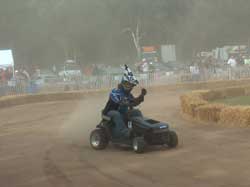Top U.S. Lawn Mower Racer Vies for Bragging Rights
- 8 ago 2006
The venue is a circular dirt track and center field is decorated with haystacks.
The crowd is loud but their cheers are drowned out by the roar of engines. The
racers glance through helmets nose to nose at each other through dust clouds in
the growing world of lawnmower racing.
Enthusiasts run the gamut from amateurs to organized racing teams. There is the U.S. Lawnmower Racing Association (USLMRA) and one time events that crop up across the country. There is also the 24-hour LeMans of Lawnmower Racing in Europe.
David Lewis is in the BP class which features modified twin cylinder engines that can reach speeds up to 50 + mph. He is ranked 15th out of 67 nationwide. There is a points system in place, from 100 points just for registering for a race to 300 points for 1st place.
The Aurora, Illinois resident has been racing lawnmowers since 2001, participating on the USLMRA Racing Circuit. He competes for bragging rights and trophies decorated with tiny lawnmowers. “I was watching television with my dad and we happened to see a lawnmower race on ESPN2,” said Lewis. “I knew we could do it and my dad’s good friends brought over an old Sears lawnmower for us to work on. After a bit of trying things out and making sure we followed the rules we took 2nd place at our first race. That was it, we were hooked.”
Depending on the class, the top speed on the track can be from 23 mph to 50+ mph. The outside tire width is limited to 38 inches and the frame must be 4 inches off the ground at its lowest point. “I started out with a 1985 Sears Lawnmower, moved to a 2004 Murray Wide Body and now I’m racing a 1995 MTD,” said Lewis. “These machines constitute the main racing tractors we use.”
“It’s a lot of fun and not very expensive to get into,” said Lewis. “My first only cost $250, but my current racers are more expensive. It’s still cheaper than other forms of racing.” As hobbies go, it’s what you put into it. Entry level modifications can cost about $600.
Lewis races with K&N Engineering products. “I believe my K&N Filter gives me an edge when I race,” he said. “Ever since I changed from the stock “flat” style air filter to the K&N I’ve felt a change in the torque curve. It feels as though it’s breathing easier. I would not go back to the stock filter even if someone paid me.”
There is no prize money, but lawnmower racing is a serious business. You haven’t lived until you’ve seen a lawn mower burn rubber; because these racers will never mow another lawn again.
Follow David's progress throughout the racing season at the K&N news site. Find K&N products for your vehicle using the K&N application search then use the K&N dealer search to find a K&N dealer in your part of the world.
Enthusiasts run the gamut from amateurs to organized racing teams. There is the U.S. Lawnmower Racing Association (USLMRA) and one time events that crop up across the country. There is also the 24-hour LeMans of Lawnmower Racing in Europe.
David Lewis is in the BP class which features modified twin cylinder engines that can reach speeds up to 50 + mph. He is ranked 15th out of 67 nationwide. There is a points system in place, from 100 points just for registering for a race to 300 points for 1st place.
The Aurora, Illinois resident has been racing lawnmowers since 2001, participating on the USLMRA Racing Circuit. He competes for bragging rights and trophies decorated with tiny lawnmowers. “I was watching television with my dad and we happened to see a lawnmower race on ESPN2,” said Lewis. “I knew we could do it and my dad’s good friends brought over an old Sears lawnmower for us to work on. After a bit of trying things out and making sure we followed the rules we took 2nd place at our first race. That was it, we were hooked.”
Depending on the class, the top speed on the track can be from 23 mph to 50+ mph. The outside tire width is limited to 38 inches and the frame must be 4 inches off the ground at its lowest point. “I started out with a 1985 Sears Lawnmower, moved to a 2004 Murray Wide Body and now I’m racing a 1995 MTD,” said Lewis. “These machines constitute the main racing tractors we use.”
“It’s a lot of fun and not very expensive to get into,” said Lewis. “My first only cost $250, but my current racers are more expensive. It’s still cheaper than other forms of racing.” As hobbies go, it’s what you put into it. Entry level modifications can cost about $600.
Lewis races with K&N Engineering products. “I believe my K&N Filter gives me an edge when I race,” he said. “Ever since I changed from the stock “flat” style air filter to the K&N I’ve felt a change in the torque curve. It feels as though it’s breathing easier. I would not go back to the stock filter even if someone paid me.”
There is no prize money, but lawnmower racing is a serious business. You haven’t lived until you’ve seen a lawn mower burn rubber; because these racers will never mow another lawn again.
Follow David's progress throughout the racing season at the K&N news site. Find K&N products for your vehicle using the K&N application search then use the K&N dealer search to find a K&N dealer in your part of the world.










